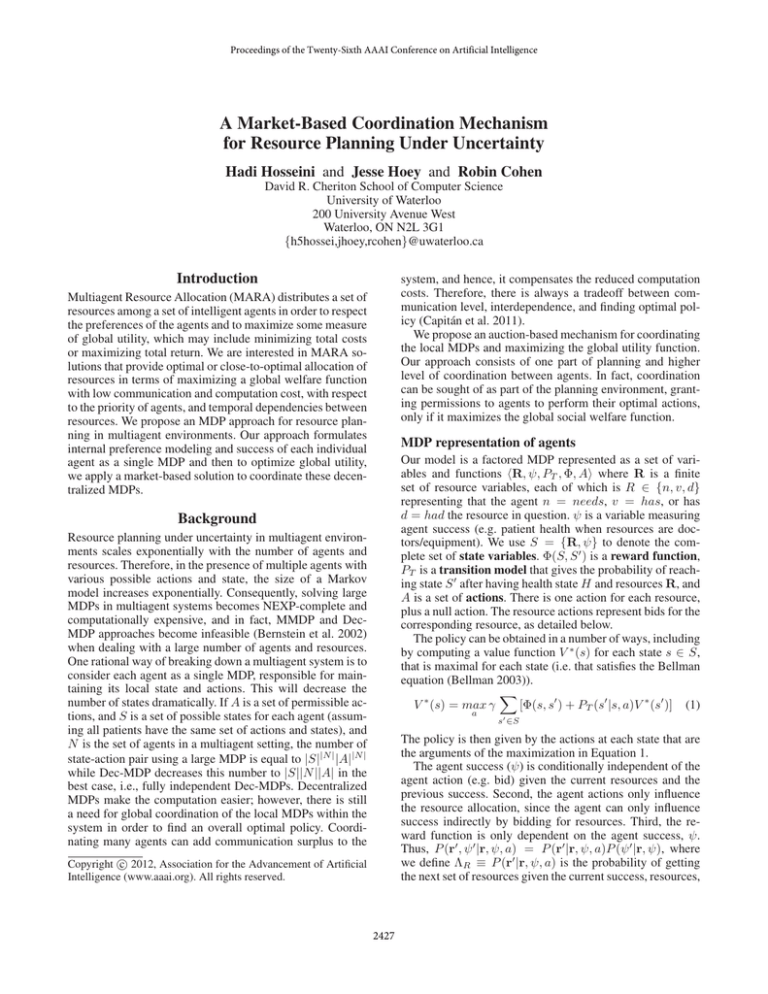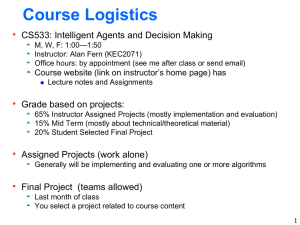
Proceedings of the Twenty-Sixth AAAI Conference on Artificial Intelligence
A Market-Based Coordination Mechanism
for Resource Planning Under Uncertainty
Hadi Hosseini and Jesse Hoey and Robin Cohen
David R. Cheriton School of Computer Science
University of Waterloo
200 University Avenue West
Waterloo, ON N2L 3G1
{h5hossei,jhoey,rcohen}@uwaterloo.ca
Introduction
system, and hence, it compensates the reduced computation
costs. Therefore, there is always a tradeoff between communication level, interdependence, and finding optimal policy (Capitán et al. 2011).
We propose an auction-based mechanism for coordinating
the local MDPs and maximizing the global utility function.
Our approach consists of one part of planning and higher
level of coordination between agents. In fact, coordination
can be sought of as part of the planning environment, granting permissions to agents to perform their optimal actions,
only if it maximizes the global social welfare function.
Multiagent Resource Allocation (MARA) distributes a set of
resources among a set of intelligent agents in order to respect
the preferences of the agents and to maximize some measure
of global utility, which may include minimizing total costs
or maximizing total return. We are interested in MARA solutions that provide optimal or close-to-optimal allocation of
resources in terms of maximizing a global welfare function
with low communication and computation cost, with respect
to the priority of agents, and temporal dependencies between
resources. We propose an MDP approach for resource planning in multiagent environments. Our approach formulates
internal preference modeling and success of each individual
agent as a single MDP and then to optimize global utility,
we apply a market-based solution to coordinate these decentralized MDPs.
MDP representation of agents
Our model is a factored MDP represented as a set of variables and functions hR, ψ, PT , Φ, Ai where R is a finite
set of resource variables, each of which is R ∈ {n, v, d}
representing that the agent n = needs, v = has, or has
d = had the resource in question. ψ is a variable measuring
agent success (e.g. patient health when resources are doctors/equipment). We use S = {R, ψ} to denote the complete set of state variables. Φ(S, S 0 ) is a reward function,
PT is a transition model that gives the probability of reaching state S 0 after having health state H and resources R, and
A is a set of actions. There is one action for each resource,
plus a null action. The resource actions represent bids for the
corresponding resource, as detailed below.
The policy can be obtained in a number of ways, including
by computing a value function V ∗ (s) for each state s ∈ S,
that is maximal for each state (i.e. that satisfies the Bellman
equation (Bellman 2003)).
X
V ∗ (s) = max γ
[Φ(s, s0 ) + PT (s0 |s, a)V ∗ (s0 )] (1)
Background
Resource planning under uncertainty in multiagent environments scales exponentially with the number of agents and
resources. Therefore, in the presence of multiple agents with
various possible actions and state, the size of a Markov
model increases exponentially. Consequently, solving large
MDPs in multiagent systems becomes NEXP-complete and
computationally expensive, and in fact, MMDP and DecMDP approaches become infeasible (Bernstein et al. 2002)
when dealing with a large number of agents and resources.
One rational way of breaking down a multiagent system is to
consider each agent as a single MDP, responsible for maintaining its local state and actions. This will decrease the
number of states dramatically. If A is a set of permissible actions, and S is a set of possible states for each agent (assuming all patients have the same set of actions and states), and
N is the set of agents in a multiagent setting, the number of
state-action pair using a large MDP is equal to |S||N | |A||N |
while Dec-MDP decreases this number to |S||N ||A| in the
best case, i.e., fully independent Dec-MDPs. Decentralized
MDPs make the computation easier; however, there is still
a need for global coordination of the local MDPs within the
system in order to find an overall optimal policy. Coordinating many agents can add communication surplus to the
a
s0 ∈S
The policy is then given by the actions at each state that are
the arguments of the maximization in Equation 1.
The agent success (ψ) is conditionally independent of the
agent action (e.g. bid) given the current resources and the
previous success. Second, the agent actions only influence
the resource allocation, since the agent can only influence
success indirectly by bidding for resources. Third, the reward function is only dependent on the agent success, ψ.
Thus, P (r0 , ψ 0 |r, ψ, a) = P (r0 |r, ψ, a)P (ψ 0 |r, ψ), where
we define ΛR ≡ P (r0 |r, ψ, a) is the probability of getting
the next set of resources given the current success, resources,
c 2012, Association for the Advancement of Artificial
Copyright Intelligence (www.aaai.org). All rights reserved.
2427
and action, and Ωψ ≡ P (ψ 0 |r, ψ) is a dynamic model for the
agent’s success rate. We will refer to ΛR as the resource obtention model and to Ωψ as the succession model.
Algorithm 2: Consumer agents: bidding mechanism
Bidding Mechanism
The bidding mechanism is based on the expected regret of not obtaining a given resource. The expected
value, Qi (ψ, r, ai ) for being in success state ψ with
resources r at time t, bidding for (denoted ai ) and
receiving
ri at time t + 1 is: Qi
≡
P
P resource
0
0 0
0
0
r0−i
ψ 0 P (ψ |ψ, r)Vi (ri , r−i , ψ )δ(r−i , r−i ), where r−i
is the set of all resources except ri and δ(x, y) = 1 ↔ x =
y and 0 otherwise. Similarly this is calculated for value for
not receiving the resource, Q̄i (ψ, r, ai ), Thus, the expected
regret for not receiving resource ri when in success state ψ
with resources r and taking action ai is:
Ri (ψ, r, ai ) = Qi − Q̄i
5
6
7
while r is nonempty do
forall the ri ∈ r, a, ψ do
Ri (ψ, r, ai ) = Qi − Q̄i
8
9
10
11
12
13
14
15
(2)
Note that Q is an optimistic estimate, since the expected
value assumes the optimal policy can be followed after a single time step (which is untrue). This myopic approximation
enables us to compute on-line allocations of resources in the
complete multiagent problem, as described later in the paper.
16
foreach Timeslot t do
rt ← r;
while rt is nonempty ∧ scheduletj is empty do
i ← arg maxi∈r {Ri };
submit bidij to resource i;
if j is winner then
update(ri , t);
remove ri from r;
else remove ri from rt
and evaluation purposes. We have shown, in simulation, that
our approach provides an effective allocation of resources
to the agents by increasing the overall social welfare (health
state of the patients) while coping with stochastic, temporal,
and dynamic elements (beyond models like (Paulussen et al.
2003)).
We are planning to illustrate the effectiveness of our approach from a theoretical point of view by proposing mathematical proofs for the lower and upper bounds of our approximate solution. In future work, we would like to refine our
model to incorporate more sophisticated bidding languages
(Nisan 2000) to better cope with combinatorial problems
where agents need to expose a richer preference model in
order to optimize the allocation process.
Market-Based Coordination of MDPs
We propose a simple auction-based mechanism where
agents send their current estimates of regret to resources that
allocate their timeslots in an iterative auction (Algorithm 1).
Algorithm 1: Resource agents
1
2
3
4
5
6
1
2
3
4
Input: A condition profile including a set of needed resources
Output: Bid values, schedule
// Initialization
begin
ΛR ∼ Dir(αr );
// resource obtention
Ωψ ∼ Dir(αψ );
// succession model
Solve MDP;
Input: Set of resources R, set of bids
Output: Mapping of agents to timeslots
initialization;
foreach Timeslot t do
resource: open up auction for t;
Bidt ← receive(bidj ) ;
// bid from agent j
jt = arg maxj∈N {bidj } ;
// awarding phase
alloc(Aj , t);
References
Bellman, R. 2003. Dynamic programming. Courier Dover
Publications.
Bernstein, D.; Givan, R.; Immerman, N.; and Zilberstein, S.
2002. The complexity of decentralized control of Markov
decision processes. Mathematics of operations research
27(4):819–840.
Capitán, J.; Spaan, M.; Merino, L.; and Ollero, A. 2011. Decentralized multi-robot cooperation with auctioned pomdps.
In Sixth Annual Workshop on Multiagent Sequential Decision Making in Uncertain Domains (MSDM-2011), 24.
Nisan, N. 2000. Bidding and allocation in combinatorial
auctions. In Proceedings of the 2nd ACM conference on
Electronic commerce, 1–12. ACM.
Paulussen, T.; Jennings, N.; Decker, K.; and Heinzl, A.
2003. Distributed patient scheduling in hospitals. In International Joint Conference on Artificial Intelligence, volume 18, 1224–1232. Citeseer.
The auction proceeds in an iterative fashion, and each
consumer agent bids on the resource with highest regret first
(Algorithm 2). The highest bidder is considered to have a
higher expected regret for not getting a resource. If an agent
does not win the auction for its highest regret resource, it
waits until the auction for its second highest regret resource
becomes available. It can also decide to give up, and is then
resigned to not having any resources in the next time step
(which may be a better option than taking a resource ahead
of time). While this iterative auction mechanism is not optimal, it is demonstrated to work well in simulated environments.
Validation and Future Direction
To validate this approach, we have adopted a healthcare resource allocation problem. Since the medical procedures and
uncertainty in patient behaviors require stochastic analysis,
the healthcare domain is a prime candidate for our analysis
2428




